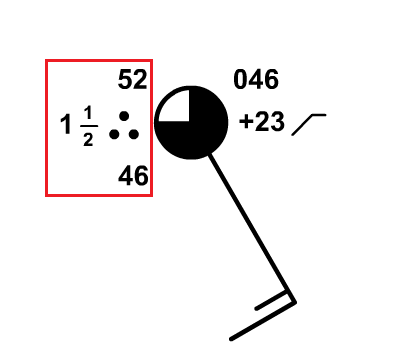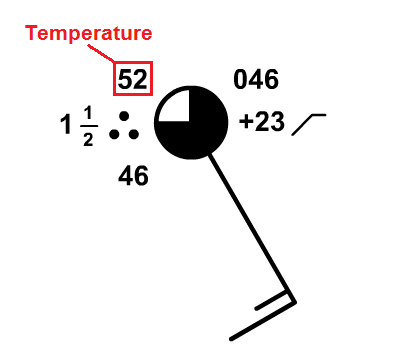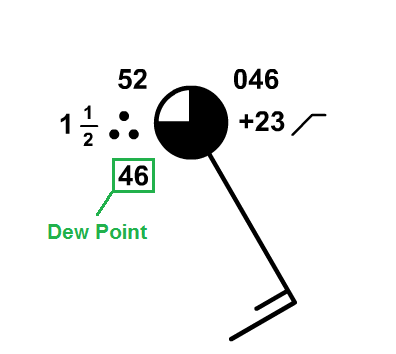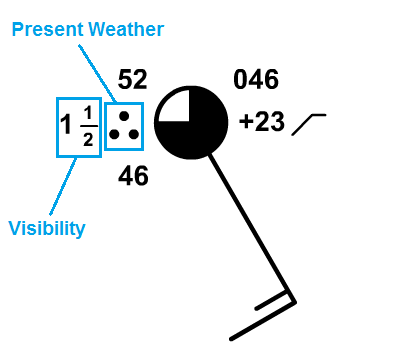How to Read a Weather Station Model

A sample of a station model with temperature, dew signal, visibility, and present conditions boxed in cherry.
Credit: David Babb
For meteorologists, the first footstep in studying the atmosphere is making observations. Commonly, meteorologists display these observations in something called a station model (check out the example on the right), which is a graphical template showing electric current conditions weather condition at a conditions station (ofttimes located at an airdrome). Over the adjacent couple of sections, I'one thousand going to innovate you lot to the key variables displayed on the station model and bear witness you how to translate one. On this page, we're going to focus on temperature, dew point, visibility, and "present atmospheric condition" (obstructions to visibility), which I've put in a carmine box in the station model on the correct.
I'll briefly talk over each variable (what it is and its mutual units of measurement), and so I'll discuss how y'all can interpret each one on a station model. Allow's start with something I'yard sure you're familiar with--temperature.
Temperature: While yous probably think of temperature equally "how hot or common cold something is," that's a pretty cryptic definition (since "hot" and "common cold" are somewhat subjective). More precisely, temperature is a mensurate of energy. Y'all run across, air molecules are restless little lumps of matter, continually vibrating, wriggling and bumping into their many neighbors. As air temperature increases, the molecular trip the light fantastic toe becomes increasingly corybantic. At a temperature of 72 degrees Fahrenheit, the average speed of air molecules is about ane,000 miles an 60 minutes, which translates into ample kinetic energy (energy of motility). Thus, air temperature is a measure of the boilerplate kinetic energy of air molecules.
In the U.s.a., we typically express temperature using the Fahrenheit temperature scale, but most countries in the globe use the Celsius temperature scale (undoubtedly, you've heard temperature expressed in "degrees Fahrenheit" or "degrees Celsius" earlier). Past the mode, if you lot ever need to convert between the two scales, the National Weather condition Service temperature conversion computer is great!
To give y'all some weather context, the Northward American all-time marks for highest and lowest temperatures are, respectively, 134 degrees Fahrenheit (56.7 degrees Celsius) in California'south Death Valley, and minus 81.4 degrees Fahrenheit (minus 63 degrees Celsius) at the village of Snag in the Yukon Territory of Canada. You may also exist familiar with some (not-conditions) mutual temperature markers:
- 100 degrees Celsius (212 degrees Fahrenheit) is the boiling point of water
- 37 degrees Celsius (98.6 degrees Fahrenheit) corresponds to normal torso temperature
- 22.2 degrees Celsius (72 degrees Fahrenheit) represents the "platonic" room temperature
- 0 degrees Celsius (32 degrees Fahrenheit) is the melting signal of ice
There are other temperature scales likewise Celsius and Fahrenheit. For case, there's the Kelvin scale (sometimes called the "accented temperature calibration"). Please note that the number of kelvins = the number of degrees Celsius + 273.15. So, the melting point of water is 273.15 kelvins and the boiling betoken of water, at standard pressure, is 373.fifteen kelvins. For the record, it'south bad form to say "degrees kelvin." Indeed, the proper style to express the units of absolute temperature is simply "kelvins." The Kelvin scale is used unremarkably in the physical sciences, and in fact it'southward the most straight way to draw the relationship between the average speed of air molecules and their temperature (higher temperatures = faster boilerplate molecule speeds).

A sample of a station model with temperature (52 degrees Fahrenheit) annotated.
Credit: David Babb
On a station model, reading the temperature is pretty easy. The number located in the upper-left corner of the model is the station temperature expressed in degrees Fahrenheit (or Celsius, depending on the state of origin). In the case of the station model on the right, the temperature is 52 degrees Fahrenheit. Unless otherwise indicated, yous can assume in this course that nosotros're using degrees Fahrenheit on the station model.
Dew Point: By definition, the dew point is the approximate temperature to which the h2o vapor (the gaseous grade of water) in the air must exist cooled (at constant pressure) in order for it to condense into liquid water drops. Nosotros're going to talk a lot more about dew bespeak subsequently on, but for now, focus on the fact that dew signal is a temperature, so it'southward typically expressed in degrees Fahrenheit or Celsius.
Equally it turns out, the dew betoken temperature is also an absolute measure of the amount of water vapor present. The college the concentration of water vapor, the higher the dew point, and as such, the dew point affects the fashion the air "feels" – whether information technology exist dry or muggy. Since our skin temperature is regulated to some degree by evaporation of sweat, it would be logical that nosotros would exist affected to some caste by the dew point temperature. Certainly, describing how something "feels" can be a bit dicey in a science course because it's a somewhat subjective topic, but examine the table below for a rough guide on how the air might "experience" based on dew point temperature.
| Dew Indicate | Full general level of comfort |
|---|---|
| 60 degrees | For most people, the air starts to feel a tad "muggy" or "sticky." |
| 65 degrees | The air starts to feel "muggy" or "sticky." |
| 70 degrees | The air is sultry and tropical and more often than not uncomfortable. |
| 75 degrees or college | The air is oppressive and stifling. |

A sample of a station model with dew point (46 degrees Fahrenheit) annotated.
Credit: David Babb
Finding the dew indicate on a station model is also pretty easy. The number located in the lower-left corner of the model is the station dew betoken in degrees Fahrenheit (or Celsius depending on the country of origin). In the case of the station model on the right, the temperature is 46 degrees Fahrenheit.
Visibility and Nowadays Weather condition: I'1000 going to cover these two observations together since they're highly related. Meteorologists are very interested in the horizontal visibility (essentially, how far you can encounter) considering information technology has major implications for transportation. If visibility is very low, conditions tin can be quite hazardous for drivers or landing aircraft!
Horizontal visibility can run the gamut. On a perfectly clear day, you can't see forever, just visibility can reach approximately 100 miles in the mountainous western U.S. On the other hand, visibility can lower to well-nigh goose egg in heavy, "pea-soup" fog, fierce blowing and/or falling snow, blowing sand/grit, smoke, etc. On a station model, the visibility is expressed in miles in the United states (yous tin assume we're using miles in this class, unless noted otherwise), and is located beneath and to the left of the temperature.

A sample of a station model with a visibility of one-and-a-one-half miles because of moderate rain.
Credit: David Babb
On the annotated station model to the right, I've labeled the visibility (i ane/2 miles, in this instance). Please note, however, that if visibility is not greatly reduced, it is often omitted from the station model. However, if visibility is reduced to seven miles or less, the offending obstruction to visibility ("nowadays weather") is also included in the station model, immediately to the correct of the visibility and merely below the temperature. While in that location are many, many possible symbols, hither are the well-nigh commonly used symbols for nowadays weather. In the sample station model to the right, the three "dots" indicate that moderate rain was the culprit, reducing visibility to ane-and-a-one-half miles. If y'all're interested, here'southward a very comprehensive list showing the wide diverseness of possible present conditions symbols (although some of these very rarely go used).
Because of the varying degrees that precipitation can reduce horizontal visibility, the qualifiers of light, moderate, or heavy are added (such as "calorie-free pelting" or "heavy snow"). I should besides note that if precipitation is falling, information technology is always reported on the station model, no matter how calorie-free or how little it affects visibility. But, every bit I mentioned before, not-precipitating obstructions to visibility (fog, haze, and smoke are perhaps the well-nigh mutual) are only reported in the station model when visibility drops to 7 miles or less.
Ultimately, while y'all don't need to memorize every single symbol for present weather, you should spend some time familiarizing yourself with the common ones, and you should certainly memorize the location of temperature, dew indicate, visibility, and present weather on the station model. To help yous go started, take some time to examine the Key Skill box below.
Source: https://www.e-education.psu.edu/meteo3/l1_p5.html
0 Response to "How to Read a Weather Station Model"
Post a Comment